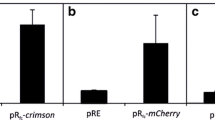Abstract.
Three environmental Mycobacterium strains (LB501T, LB307T and VM552) able to degrade anthracene, phenanthrene or pyrene, respectively, were successfully electroporated with pAL5000-based plasmids containing the green fluorescent protein (gfp) gene of Aequoria victoria under the control of the hsp60 promoter of Mycobacterium bovis following a slightly modified standard procedure. Transformants showed irregular gfp expression profiles. Four plasmid derivatives were constructed that contained gene promoters isolated from, and adapted to, gene expression in polycyclic aromatic hydrocarbon (PAH)-degrading mycobacteria. One derivative directed strong and homogeneous expression of GFP, allowing dual analysis of both GFP- and PAH-derived fluorescence as assessed by confocal laser scanning microscopy. The results reported here demonstrate the suitability of the pAL5000 replicon for the development of recombinant DNA-based studies in PAH-degrading Mycobacterium spp.
Similar content being viewed by others
Author information
Authors and Affiliations
Corresponding author
Rights and permissions
About this article
Cite this article
Wattiau, P., Springael, D., Agathos, S.N. et al. Use of the pAL5000 replicon in PAH-degrading mycobacteria: application for strain labelling and promoter probing. Appl Microbiol Biotechnol 59, 700–705 (2002). https://doi.org/10.1007/s00253-002-1081-x
Received:
Revised:
Accepted:
Published:
Issue Date:
DOI: https://doi.org/10.1007/s00253-002-1081-x




